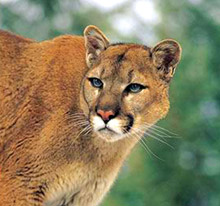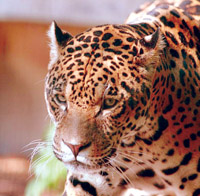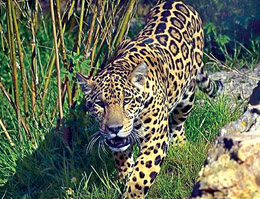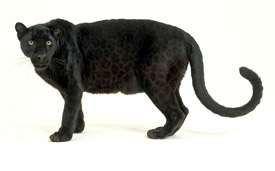Felines: wild and beautiful
The cougar and jaguar
Cougar (Puma concolor)
The largest of the small wild cats, sometimes also classed as a big
cat, the cougar holds the world record as the animal with the most
names. It is called by over 40 names in English alone and some of the
more popular names are; puma, mountain lion, panther, catamount, red
tiger and Florida panther.
 Native to the Americas, the cougar is a large, solitary cat. It has
the greatest range of any terrestrial (living on land) mammal in the
Western Hemisphere. It is distributed from Yukon to Canada to the
Southern Andes of South America. Native to the Americas, the cougar is a large, solitary cat. It has
the greatest range of any terrestrial (living on land) mammal in the
Western Hemisphere. It is distributed from Yukon to Canada to the
Southern Andes of South America.
The second heaviest cat in the New World after the jaguar, the cougar
is a reclusive animal which avoids people. Its preferred habitats are
dense under-brush and rocky areas which are ideal for stalking. It is
also found roaming in open areas.
Slender and less muscled than the jaguar, the cougar varies in size;
the smallest species are found near the equator and the largest towards
the Poles. Some cougars can be as big as the jaguars. On average, a
cougar reaches a height of 60-80 cm (2.0 to 2.7 ft) at the shoulder and
a length of 2.4 m (8 ft) from nose to tail.Even though the cougar is not
as powerful as the jaguar, it has powerful forequarters, neck and jaws
which help it to grasp and hold large prey. It locates prey by scent and
sound.
The cougar generally stalks and ambushes a wide variety of prey -
ungulates (hoofed mammals) such as deer, sheep (which are its prime
food) and even domestic cattle and horses. It also hunts species as
small as insects and rodents and is known to eat porcupines, raccoons
and mice. It also eats grass! It has retractable claws, adaptable to
clutching prey; four on its hind paws and five on its forepaws including
one dew claw (rudimentary inner toe).
The paws are large and proportionately it has the largest hind legs
in the cat family. The large paws and hind legs allows the cat to make
great leaps and also sprint. Its head is round and the ears are erect.On
average, the cougar is heavier than the leopard and weighs 53 to 72 kg
(115-160 lbs). Cougars weighing 200 lbs have also been recorded.It has a
plain coloured fur coat which could vary from sibling to sibling and
even between individuals in the area. Typically tawny, the colour ranges
from silver-grey to a reddish hue. Lighter patches than the base colour
appear on the underside, jaw and throat areas. After a gestation period
of about 91 days, the female gives birth to a litter comprising one to
six kittens. Born blind like all kittens, the cougar kittens too open
their eyes after 7-10 days.
Parenting is done by only the mother in a maternity den which is
usually located in a rock shelter, crevice, thicket or cave. The ground
is lined with moss and vegetation. The young have heavily spotted coats
for the first three months. It is around this same time that they are
weaned and start hunting with mum. The cubs stay with the mother until
they are about one to two years.
The home range of a single male cougar can be as large as 175 square
miles. A male may travel up to 25 miles (40 km) when hunting at night.
Cougars hunt both day and night, but they are most active at dawn and
dusk.
Once hunted to near extinction, the cougar has now made a comeback
and in recent years, the populations have expanded into Western United
States too. The life expectancy in the wild is between 8-13 years and
probably average around 8-10 years. The World Conservation Union (IUCN)
lists the cougar as near threatened.The cougar communicates by licking,
rubbing its body against trees or the other animals, especially cubs and
mate and also by vocalising. Itís famous for its blood-curdling mating
call.
A cougar not only screams, but also makes low-pitch hisses, growls,
chirps and whistles. One of the reasons itís not typically classed among
big cats is because of its inability to roar. It can only purr, like a
domestic cat. A piercing whistle is used to signal the cubs by the
female. The young cougars produce chirping whistles.The cougar can leap
up onto trees about 20 feet high and also jump to the ground from trees
as high as 60 feet!
When hunting, the cougar usually stalks its victim to within 30 ft (9
m) and then rushes in from its hiding place to capture and kill it. The
cougar jumps generally at the victimís neck with its hind legs firmly
planted on the ground for support, control and stability.The grace and
power of the cougar has been greatly admired in the culture of the
indigenous peoples of Americas.In fact, the Inca City of Cusco is said
to be designed in the shape of a cougar. Because of its power, many
items, especially sports items, are branded with its name.
Jaguars (Panthera onca)
A New World mammal, the jaguar is one of the four big cats in the
Panthera genus. Tigers, lions and leopards belong to the Old World.
 The largest and most powerful cat in the Western Hemisphere, its
present range extends from Mexico, Central America south to Paraguay and
Argentina. The largest and most powerful cat in the Western Hemisphere, its
present range extends from Mexico, Central America south to Paraguay and
Argentina.
The jaguar is very similar to the leopard and is sometimes mistaken
for a leopard, but its build is sturdier than a leopardís. Compact and
well muscled, significant variations have been noted in size. Typically,
females are 10 to 20 per cent smaller than the males that weigh between
56-96 kg (124-211 lbs) on average. The body length too varies; but on
average it ranges between 1.62 and 1.83 m (5.3 - 6 ft). Its tail length
is about 75 cm (30 in). The jaguar stands at 67-76 cm (27-30 in) at
shoulder height.
One of the ways a jaguar can be distinguished from a leopard is by
the rosettes on the coat. Jaguars have larger, but a fewer amount of
rosettes which are usually darker, with thicker lines and small spots in
the middle. The rosettes vary and merge at the tail to form rings. The
base colour of the coat is tawny yellow in general, but ranges from
reddish brown to black, as melanism is reported among jaguars. In the
South American range, about six per cent of the jaguar population is
melanistic. The underbelly, throat, outer surface of legs and flanks are
white.
The second strongest of all mammals, its short, sturdy body makes it
adept at climbing, crawling and even swimming. It has a robust head and
powerful jaws.
In behaviour and selection of habitats, the jaguar is closer to the
tiger, even though its appearance is like that of a leopard. It is found
in dense forests (profound habitat), and also in forested and open
territories. Along with the tiger it is noted as a feline that enjoys
water.
An opportunistic hunter, its diet comprises 85 species which includes
large prey such as deer, anacondas, caiman and capybaras and smaller
prey such as frogs, mice, birds, fish, sloths, monkeys, turtles and
domestic livestock.
Both males and females hunt, but males travel further than the
females each day. The cougar is a nocturnal and crepuscular(active in
twilight) hunter. It is also a solitary hunter and adopts the stalk and
ambush technique when hunting.
Relative to the big cats, it has developed an exceptionally powerful
bite; directly into the skull between the ears of prey to cause a fatal
blow to the brain. This is its preferred method of killing prey, but it
also resorts to the deep throat bite and suffocation techniques which
are typical among the Panthera genus. The skull bite technique is
employed mostly with mammals. It has the power to damage the temporial
bones, especially in the capybara, with its powerful canine teeth.
After a gestation period of 93-105 days, the female gives birth to a
litter comprising up to four cubs. Weaned at three months, the cubs
continue to remain in the den until they are about six months. Like the
cubs of cougars and most big cats, the jaguar cubs too stay in the
company of their mother until they are about one or two years of age.
A jaguarís lifespan is between 12-15 years, but in captivity, there
are records of it living for even 23 years. The jaguar too has featured
prominently in the mythology of numerous American cultures such as the
Aztecs and Mayans. It is among the fastest animals and is capable of
reaching speeds between 112 kilometres per hour (70 mph) according to
experts.
What is melanism?

|

There is no distinct species of wild cat called a black panther. |
Have you heard of albinism or seen animals and people affected by it?
The victims are generally called albinos. Well, melanism is the opposite
of albinism. But, while in albinism those affected display pale skin
(pinkish), light hair, fur etc, in animals affected by melanism, the
opposite occurs. An increased amount of black or nearly black
pigmentation of an organism, resulting from the presence of melanin
leads to melanism. Many examples of melanism have been recorded in the
animal world, especially among felines; leopards and jaguars with this
condition are often called black panthers although cougars are also
known as panthers. There is no distinct species of wild cat called a
black panther. It has become a common name today for any black coloured
variant of any species of cat affected by melanism. Melanism (derived
from the word melanin), in jaguars is due to dominant gene mutation. In
leopards however, it is due to a recessive gene mutation. Even though
the cat appears fully black at first glance, closer examination would
reveal that the typical markings are still existing, though hidden by
the black pigment. In humans, melanin (dark pigments) leads to tanning
when exposed to sunlight.
Even though animals with melanism are normal and not different to the
original animals (except in colour), animals with albinism are generally
affected with health problems. Albino cats may be deaf. Rodents with
albinism have red eyes, but most animals with albinism have blue eyes
and pink skin and white fur/feathers.
Melanism occurs in a variety of animals including mammals, reptiles
and insects.
Fact file: Big and small cats
 * One definition of big cats includes only the four species of cat in
the genus Panthera ; the lion, tiger, leopard and jaguar. It is only the
members of this genus in the family of cats (Felidae) that are able to
roar. All the others can only purr and make various other sounds. * One definition of big cats includes only the four species of cat in
the genus Panthera ; the lion, tiger, leopard and jaguar. It is only the
members of this genus in the family of cats (Felidae) that are able to
roar. All the others can only purr and make various other sounds.
* A more expansive definition of big cats include the cheetah, snow
leopard, clouded leopard and the cougar.
* The roaring cats are also known as Ďgreat catsí.
* The young of big cats are always called cubs, but those of other
cats are generally referred to as kittens.
* The origin of the Felidae family can be dated back to about 11
million years of age and to the Asian region.
Cougars and jaguars
* Research has revealed that cougars and jaguarundies are closely
related to the modern cheetah of Africa and Western Asia.
* Melanism has not been observed in cougars.
* Cougar cubs have spotted coats and blue eyes. Juveniles are pale
and have dark spots on flanks. |
